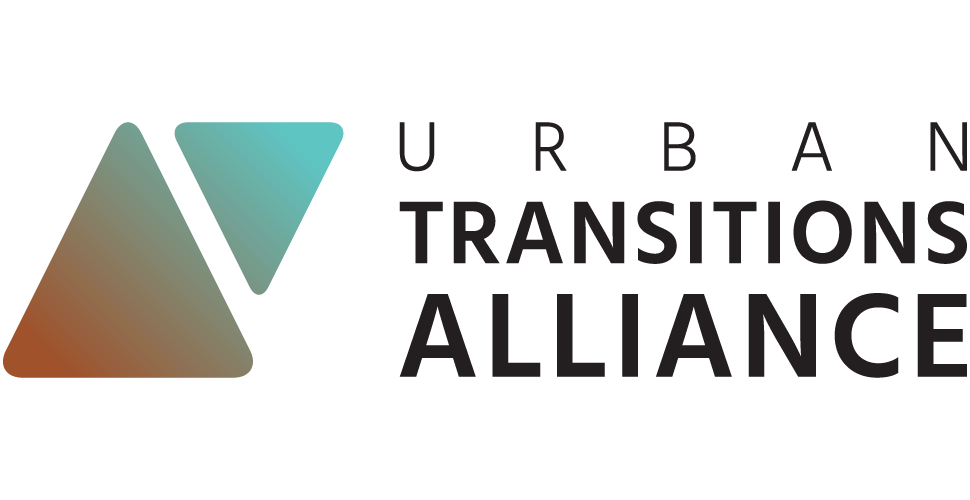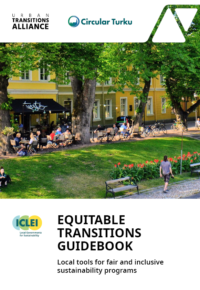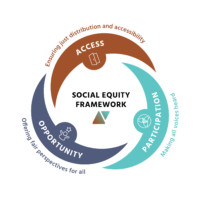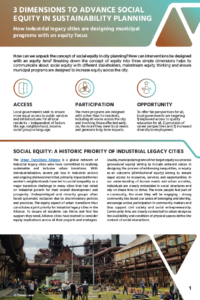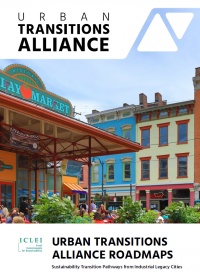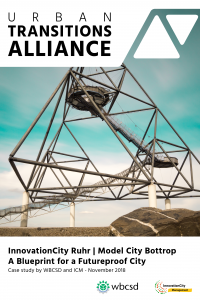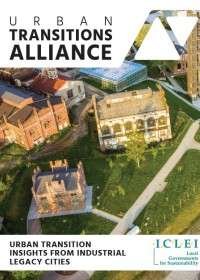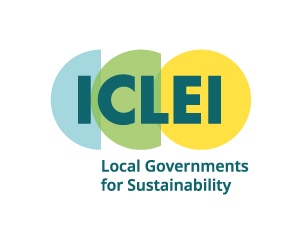PUBLICATIONS
Read up on transition insights and Alliance case studies from industrial legacy cities.
The knowledge is captured from the Urban Transitions Alliance exchanges
and reflects the cities’ joint thematic priorities.
Infrastructure Transition
Social Transition
Energy Transition
Mobility Transition
Equitable transitions guidebook: Local tools for fair and inclusive sustainability programs
The collaboration under the Urban Transitions Alliance led to the development of a methodology that allows mapping the social equity outcomes of local sustainability plans across three dimensions: access, participation and opportunity. The Equitable Transitions Guidebook provides insights and recommendations illustrated with best practices, resources and tools for city practitioners to better understand and unpack what social equity means for sustainability programs at the local level.
Published on 30 June 2022
Urban Transitions Alliance equity framework: How industrial legacy cities are advancing climate justice locally
How can ambitious climate targets be aligned with social equity considerations to ensure no local residents or communities are left behind in the transition? Breaking down the concept into the three dimensions of ACCESS, PARTICIPATION and OPPORTUNITY, the Urban Transitions Alliance equity framework provides a hands-on approach for cities to locally accelerate climate justice and social equity.
Published on 29 October 2021
Urban Transitions Alliance equity paper: 3 dimensions to advance social equity in sustainability planning
How can we unpack the concept of social equity in city planning? How can interventions be designed with an equity lens? Breaking down the concept of equity into three simple dimensions helps to communicate about social equity with different stakeholders, mainstream equity thinking and ensure municipal programs are designed to increase equity across the city.
Published on 30 September 2020
Urban Transitions Alliance Roadmaps:
Sustainability Transition Pathways from Industrial Legacy Cities
The Urban Transitions Alliance was built on the premise that by connecting industrial legacy cities from the US, Europe and China through their transition stories and visions of sustainable urban development, common challenges and transition pathways would emerge. The Alliance was designed to provide the infrastructure and support to advance collaboration between the cities. This report details four transition pathways that the cities have undertaken, with implementation ideas and best practices for each.
Published on 22 April 2019
Download the Executive Summary (PDF)
Infrastructure Transition Roadmap
Industrial legacy cities have a spectrum of options at their disposal to drive their infrastructure transitions. These range from strict industrial heritage conservation to complete demolition with various hybrid approaches in between. Similarly, they can either be the ones directly financing and implementing these measures or those that enable other stakeholders to put them into practice. Thereby, they need to balance economic, environmental and social considerations and take into account the historical and cultural value of the physical infrastructure in question.
Featured Cities
Gelsenkirchen, Germany
Katowice, Poland
Dortmund, Germany
Baltimore, USA
Beijing Huairou, China
Energy Transition Roadmap
Energy efficiency initiatives within the Alliance cities and districts have taken all shapes and forms, and most importantly have engaged large numbers of stakeholders. Examples on how cities apply and adapt energy efficiency programs within city hall, citizens’ homes and large-scale commercial and industrial infrastructures are illustrated in this solution roadmap. These diverse and collaborative initiatives showcase how energy efficiency programs and investments help to reinforce the Alliance cities’ commitment to improving their sustainability and building inclusive communities.
Featured Cities
Buffalo, USA
Katowice, Poland
Pittsburgh, USA
Cincinnati, USA
Beijing E-Town, China
Mobility Transition Roadmap
Many cities in the Alliance have implemented policies to support cycling and walking infrastructure and expand public transport. However, such efforts have not yet achieved to accelerate a change of modal split. What can cities do to leverage infrastructure investments to their full potential? Clearly a missing piece is citizen buy-in. Policies aiming to achieve a mobility transition need to be developed in consultation with local communities and acknowledge individual habits and preferences. The following pathways reflect diverse approaches to increase public support and instigate wider behavioral change across the population.
Featured Cities
Cincinnati, USA
Shijiazhuang Yuhua, China
Essen, Germany
Buffalo, USA
Dortmund, Germany
Social Transition Roadmap
The Social Transition Roadmap explores the question of access to sustainable resources, awareness of the impacts linked to everyday consumption and employment opportunities generated by resource management at the local level. The initiatives outlined in this roadmap seek to reconnect local economies with the environment during production, consumption and disposal to ensure negative impacts are minimized. In that way, they demonstrate that environmental, social and economic concerns can be mutually reinforcing when cities are intentional about designing projects that play on these synergies.
Featured Cities
Pittsburgh, USA
Cincinnati, USA
Buffalo, USA
Baltimore, USA
Essen, Germany
InnovationCity Ruhr | Model City Bottrop: A Blueprint for a Future-Proof City
Bottrop, a midsize city in Western Germany, is a typical city of the Ruhr region. It is strongly influenced by coal mining and heavy industries. Its industrial character is, however, a thing of the past: Bottrop’s last coal mine will shut down at the end of 2018. Bottrop started in 2010 to get ready for the challenges of climate change. The corresponding change in energy supply, from coal to renewables, has turned out to be a good opportunity to futureproof the city. A lot can be learnt from Bottrop’s efforts to transform from an industrial center into a climate-resilient and sustainable city.
Published on 27 November 2018
Urban Transition Insights from Industrial Legacy Cities
The Urban Transitions Alliance has grown into a strong network and knowledge-exchange hub of innovative urban transitions policies and projects. It supports industrial legacy cities from China, Europe and the US to identify common challenges, share knowledge and develop solutions according to their most pressing needs and interests. The knowledge captured from the initial Alliance exchanges in the fields of infrastructure, social, energy and mobility transition has been summarized in these transition briefing sheets.
Published on 15 June 2018
Infrastructure Transition
Historically developed around extractive and manufacturing economies, deindustrialization has left many industrial legacy cities with an urban fabric no longer suitable for the 21st century. Vacant industrial land, idle factory buildings, and derelict railway tracks constitute examples of infrastructure systems in need of redevelopment. Urban Transitions Alliance cities have come a long way in transforming their outdated infrastructure and brownfields in an effort to re-invent themselves and meet their current and future needs.
Featured Cities
Gelsenkirchen, Germany
Beijing Huairou, China
Katowice, Poland
Mobility Transition
An eco-friendly and less car-dependent mobility system is a key element of industrial legacy cities’ transition towards a more sustainable future. Urban Transition Alliance cities promote a modal shift towards local public transport and non-motorized transport like cycling and walking in order to improve air quality, reduce congestion and contribute to the well-being of their citizens and increase mobility services in previously disadvantaged city districts. Opportunities to repurpose existing infrastructure like industrial-era rail ways or highways that run through urban centres are among the specific advantages of industrial legacy cities.
Featured Cities
Pittsburgh, USA
Dortmund, Germany
Shijiazhuang Yuhua, China
Energy Transition
Leading energy transitions can be complex and investment-heavy, especially for industrial legacy cities due to their historical reliance on carbon-based and extractive industries. However, these cities recognize that their pathway to a more sustainable future will be powered by clean energy. To ensure that the shift to low-carbon and renewable energy takes place, local governments need to comprehend the challenges and historical barriers they face. At the same time, by collectively using policy levers and innovative actions – industrial-legacy cities are already building momentum and support for their energy transition visions.
Featured Cities
Beijing E-Town, China
Cincinnati, USA
Katowice, Poland
Social Transition
The social transition is about people. When industrial legacy cities restructure their social and economic systems, a key concern is that no person or social group is excluded or left behind in the transition to a more sustainable future. Instead of playing environmental, social and economic aspects of the transition off against each other, local governments can leverage their synergies to increase social inclusion and equity. Cities across the Urban Transitions Alliance are continually exploring new ways to engage their citizens and create opportunities for them to thrive.
Featured Cities
Baltimore, USA
Essen, Germany
Buffalo, USA
